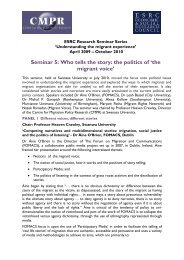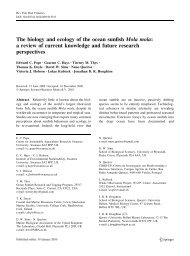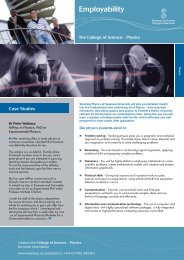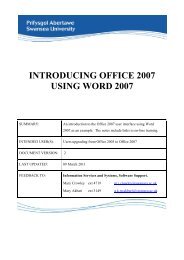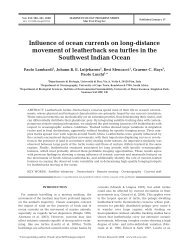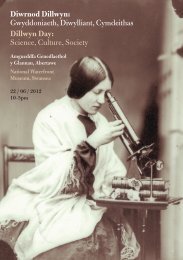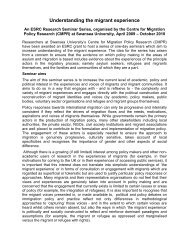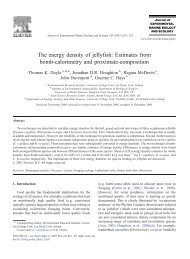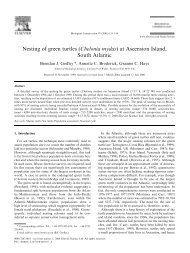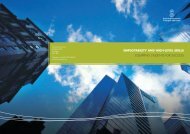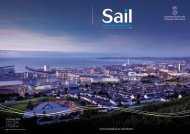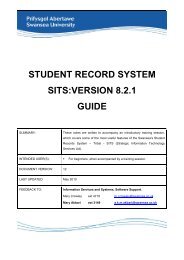Momentum-February-2013 - Swansea University
Momentum-February-2013 - Swansea University
Momentum-February-2013 - Swansea University
Create successful ePaper yourself
Turn your PDF publications into a flip-book with our unique Google optimized e-Paper software.
<strong>Momentum</strong><br />
Research news from <strong>Swansea</strong> <strong>University</strong><br />
Issue 9 : <strong>February</strong> <strong>2013</strong><br />
In this issue<br />
• Memory, community, football: historians capture 100 years of <strong>Swansea</strong> City<br />
• How supercomputing supports <strong>Swansea</strong> research<br />
• Greenland glaciers and food festivals - research in profile
2 <strong>Momentum</strong> | Issue 9 | <strong>February</strong> <strong>2013</strong><br />
Welcome to the <strong>February</strong> <strong>2013</strong> edition<br />
of <strong>Momentum</strong>.<br />
The city of <strong>Swansea</strong> is currently gripped<br />
by football fever as the local team head<br />
to Wembley for their first ever cup final.<br />
So we report on a history research<br />
project gathering fans’ memories and<br />
experiences of supporting their club<br />
through thick and thin.<br />
We also look at pioneering work on<br />
diabetes, one of the biggest health<br />
challenges of the 21st century, at research<br />
into food festivals, and at how<br />
supercomputing is supporting <strong>Swansea</strong><br />
researchers working in health and physics.<br />
Fending off polar bears? It’s all in a day’s<br />
work if you’re a glaciology researcher, as<br />
you can see in our Great Minds feature.<br />
With so much fascinating research going<br />
on across campus, it was good to see<br />
images from our Research as Art<br />
competition featured in a special exhibition<br />
at the Royal Institution in London – read<br />
more on page 6.<br />
In this issue<br />
Page 3 World-leading research – why<br />
and how we focus on it<br />
Page 4 Research highlights – diabetes,<br />
100 years of <strong>Swansea</strong> City<br />
Page 6 How supercomputing supports<br />
<strong>Swansea</strong> research<br />
Page 8 Research round-up<br />
Page 10 Graduate success – Nia Bryer,<br />
director, Old Bell 3 Research<br />
Page 11 Great Minds: Prof Tavi Murray<br />
Page 12 Postgrad research: Kate Stacey,<br />
marketing and food festivals<br />
P5<br />
P4<br />
P6<br />
On the cover<br />
Pictures gathered by the Swans 100<br />
project, based in the <strong>University</strong><br />
history department, which is<br />
capturing fans’ memories of the<br />
first 100 years of <strong>Swansea</strong> City<br />
Football Club.<br />
The main picture<br />
is of present-day<br />
fans at the club’s<br />
home ground,<br />
the Liberty<br />
Stadium.<br />
The picture on<br />
the left shows<br />
fans from the<br />
1960s. On the<br />
right is the aptly-named Billy Ball, who<br />
scored the Swans’ first ever goal, in their<br />
debut game as a professional team,<br />
against Cardiff City, on 7 September<br />
1912. The game ended 1-1.<br />
More on the Swans 100 project on<br />
page 5.<br />
P9<br />
<strong>Momentum</strong> is produced by the<br />
Marketing Department.<br />
Please contact Kevin Sullivan on<br />
+44 (0) 1792 513245 or<br />
email k.g.sullivan@swansea.ac.uk<br />
for further information.<br />
© <strong>Swansea</strong> <strong>University</strong> <strong>2013</strong><br />
<strong>Swansea</strong> <strong>University</strong> is a registered charity.<br />
No. 1138342.<br />
P11<br />
For more details about<br />
<strong>Swansea</strong> <strong>University</strong>’s research
Issue 9 | <strong>February</strong> <strong>2013</strong> | <strong>Momentum</strong> 3<br />
World-leading research<br />
<strong>Swansea</strong> <strong>University</strong> research has<br />
recently been in the spotlight with the<br />
launch of Breakthrough, a major report<br />
which showcases some of the worldclass<br />
research projects under way in our<br />
institution. Some of these are also<br />
featured in this issue of <strong>Momentum</strong>.<br />
Professor Noel Thompson and Professor<br />
Ian Cluckie, Pro Vice Chancellors for<br />
research, explain our research focus<br />
across the <strong>University</strong>.<br />
<strong>Swansea</strong> <strong>University</strong> has achieved recognition as<br />
a truly research-intensive institution through a<br />
successful policy of targeted intervention and<br />
investment. The <strong>University</strong> produces<br />
internationally excellent and world-leading<br />
research across all disciplines and displays<br />
particular strength in Science, Technology,<br />
Engineering and Mathematics (the STEM<br />
subjects), Medicine and Life Science, Social<br />
Sciences, and the Arts and Humanities.<br />
The results of the last (2008) Research<br />
Assessment Exercise (RAE) speak volumes: the<br />
largest increase in internationally excellent and<br />
world-leading research in the whole of the UK,<br />
with more than 90% of our academic staff<br />
classed as research active.<br />
<strong>Swansea</strong> <strong>University</strong> is currently ranked 29th in the<br />
UK in terms of research income as a proportion of<br />
turnover, and our College of Engineering is<br />
performing on a par with universities in the Russell<br />
Group. Moreover, for every £1 million of Higher<br />
Education Funding Council for Wales research<br />
grant awarded, we now secure more than £2.5<br />
million of competitive research funding from a<br />
wide variety sources.<br />
<strong>Swansea</strong>’s approach to research builds on the<br />
aspirations of our founders, who in 1920 set out<br />
to respond to the requirements of industry but<br />
also recognised in the breadth of its foundation<br />
disciplines what makes for a <strong>University</strong>. The first<br />
foundational Chairs created reflected this with<br />
appointments in Engineering, Metallurgy,<br />
Physics, Mathematics, Chemistry, History and<br />
English and with Dr Mary Williams becoming<br />
the first woman to be appointed to a Chair at a<br />
British <strong>University</strong> when she became Professor of<br />
French Language and Literature in 1921.<br />
Recent progress has been impressive but our<br />
challenge now is to accelerate that momentum.<br />
We have pledged to continue our policy of<br />
strategic appointments; to sustain the growth of<br />
research grant income through improvements in<br />
bid quality; to engage more researchers in grantwinning<br />
activities and to build effective national<br />
and international collaborations.<br />
Each of <strong>Swansea</strong>’s six Colleges house research<br />
clusters that bring together our research<br />
community with private companies, the public<br />
and the third sector, and which build our capacity<br />
to lead in emerging areas. Moreover, our<br />
campus-based setting, and researchers who have<br />
invested in interdisciplinary work, have enabled a<br />
programme of cross-college collaboration that is a<br />
distinctive and energising aspect of the <strong>University</strong>’s<br />
dynamic research environment.<br />
Decades of applied research have enriched our<br />
economy and society. The government’s<br />
growing emphasis upon impact reflects a<br />
guiding principle that informs our campus<br />
development programme with an underpinning<br />
commitment to multidisciplinary research<br />
ensuring that we combine strengths in STEM<br />
with research in the Social Sciences, Arts and<br />
Humanities, Business, Economics and Law. For<br />
only in this way can the world’s most complex<br />
and pressing challenges be addressed.<br />
The Science and Innovation Campus<br />
development heralds a new era for the <strong>University</strong><br />
and its research. This significant investment will<br />
enable us to harness research strengths to a<br />
broad range of local and transnational business<br />
Festival of Research<br />
celebrates excellence<br />
enterprises, and to promote the growth of hightechnology<br />
clusters. It will also furnish the space<br />
on the Singleton campus that will allow the Arts,<br />
Humanities, Social and Medical Sciences to<br />
realise their ambitions.<br />
Research informs all academic and student-based<br />
activities across the <strong>University</strong> and a research<br />
culture characterised by its vitality is pivotal to the<br />
future of the institution. By developing the<br />
<strong>University</strong>’s research portfolio, attracting and<br />
retaining the most talented researchers and<br />
postgraduates, and by working within and across<br />
disciplines, <strong>Swansea</strong> will continue to address the<br />
current and future challenges that confront Wales<br />
and the wider world.<br />
Professor Noel<br />
Thompson, FRHistS<br />
Pro Vice-Chancellor<br />
(Research)<br />
Professor Ian Cluckie,<br />
FREng, FRSA,<br />
Pro Vice-Chancellor<br />
(Research)<br />
A week-long showcase of public events, talks and exhibitions at <strong>Swansea</strong> <strong>University</strong> is<br />
promoting the very best of <strong>Swansea</strong> <strong>University</strong>’s research. The Festival of Research,<br />
coordinated by the Bridging the Gaps programme, is running from 25 <strong>February</strong> to 1<br />
March. Open to all – students, staff and public alike – and free of charge, the festival<br />
incudes highlights such as:<br />
• Professor Andrew Blake, Laboratory Director, Microsoft Research Cambridge,<br />
opening the festival with a public lecture, Building a Machine that Sees<br />
• Professor Dave Worsley, Research Director of the Sustainable Product Engineering<br />
Centre for Innovative Functional Industrial Coatings (SPECIFIC) project, giving his sellout<br />
Cheltenham Science Festival presentation on Future Buildings<br />
• Chris Marshall, PhD student in the <strong>University</strong>’s College of Arts and Humanities, giving<br />
a lecture on The Promised Land? Barack Obama and Martin Luther King’s “Dream”.<br />
www.swansea.ac.uk/festival-of-research<br />
More on the Festival of Research in the next issue of <strong>Momentum</strong>
4 <strong>Momentum</strong> | Issue 9 | <strong>February</strong> <strong>2013</strong><br />
Tackling today’s biggest health<br />
problems - diabetes research<br />
Danielle Jones, PhD Student in diabetes research<br />
Chronic conditions have been described by<br />
the former chief medical officer as “the<br />
twenty-first century healthcare challenge”,<br />
which is why research at <strong>Swansea</strong> into<br />
diabetes – one of the conditions which has<br />
risen inexorably in recent years – is of such<br />
pressing importance.<br />
<strong>Swansea</strong>’s diabetes research group has<br />
grown rapidly since it was established in<br />
2005. The group has expanded from 2 to<br />
around 20, including senior investigators,<br />
researchers, nurses and PhD students. Led<br />
by Dr Jeff Stephens and Professor Steve<br />
Bain the group is a cross-college<br />
collaboration between Medicine and<br />
Engineering, and has strong links to the<br />
local NHS health boards.<br />
Jeff Stephens says: “Our group has particular<br />
expertise within obesity, prediabetes and<br />
adipose biology. We also look at the genetics<br />
of type 1 and 2 diabetes and associated<br />
complications, cardiovascular disease, exercise<br />
physiology, health in the workplace and<br />
glucose and insulin homeostasis.<br />
We’re involved with a lot of clinical trials of<br />
new medical devices and therapies for type<br />
2 diabetes. We work with major<br />
pharmaceutical companies such as Lilly,<br />
Novo Nordisk, Sanofi-Aventis, Boerhinger-<br />
Ingelheim, Takeda and Astra-Zeneca”.<br />
The group’s research has been published in<br />
the leading medical journals, such as the<br />
Lancet, British Medical Journal, and New<br />
England Journal of Medicine. Their work is<br />
built on a solid foundation of collaboration<br />
with local doctors and scientists through a<br />
research forum, and good relationships with<br />
patients. In fact, the group also presents<br />
research projects to the local branches of<br />
Diabetes UK in the area to inform and gain<br />
approval from patients for their work.<br />
Diabetes Research Network<br />
A multi-disciplinary collaboration, this aims to<br />
promote existing strengths in diabetes<br />
research, and encourage more people with<br />
diabetes to get involved.<br />
Exercise physiology in diabetes<br />
This work looks at the interaction of physical<br />
exercise, nutrition and pharmaceutical<br />
interventions in the management of those<br />
with type 1 and type 2 diabetes.<br />
Basic Science<br />
This research studies the genetics of renal<br />
and cardiovascular complications in diabetes<br />
Clinical Science<br />
Several projects examining clinical and<br />
physiological aspects of diabetes are under<br />
way. These include studies examining<br />
glucose and insulin homeostasis, cardiac<br />
function and energy expenditure following<br />
bariatric surgery.<br />
Epidemiology, public health & Health<br />
informatics<br />
Collaborative research in these areas is<br />
looking at latent autoimmune diabetes in<br />
adults, and at how routine data can be used<br />
to assess blood pressure differences in primary<br />
and secondary care and any links between<br />
glucose test strips and blood sugar control.<br />
Retinopathy<br />
Research on the costs and the screening interval<br />
for diabetic retinopathy is also under way.<br />
More information: look for the diabetes link<br />
on this page:<br />
www.swan.ac.uk/medicine/research/<br />
Some of the research looks at the role of exercise
Issue 9 | <strong>February</strong> <strong>2013</strong> | <strong>Momentum</strong> 5<br />
Memory, community, football:<br />
100 years of <strong>Swansea</strong> City<br />
Programme from <strong>Swansea</strong> Town’s first game, 7 Sept 1912<br />
By the time you read this, <strong>Swansea</strong> City<br />
Football Club may have already played in<br />
the Cup Final at Wembley, having already<br />
knocked out the European champions,<br />
Chelsea, and the previous holders, Liverpool,<br />
on their way. It is a remarkable story. Only<br />
eight years ago the club was on the verge of<br />
bankruptcy and elimination from the bottom<br />
division of the Football League. Now the<br />
Swans play amongst the elite in the Premier<br />
League, the first Welsh team to do so. Win,<br />
lose or draw at Wembley, the club is already<br />
making history.<br />
<strong>Swansea</strong> Town fans from the 1920s<br />
This rollercoaster<br />
history, and the<br />
way in which it has<br />
been experienced<br />
and remembered<br />
by generations of<br />
fans, is the subject<br />
of a fascinating<br />
research project<br />
based in <strong>Swansea</strong><br />
<strong>University</strong>’s<br />
Department of<br />
History and<br />
Classics. Swans<br />
100 is a community history<br />
project, which is gathering fans’<br />
memories of the Swans to create<br />
an online archive. The project,<br />
carried out in collaboration with<br />
the Swans’ Supporters’ Trust, with<br />
funding from the Lottery, was set<br />
up in 2012, which marked the<br />
centenary of the club’s foundation.<br />
The project team, including<br />
volunteer researchers, have been gathering<br />
memories and memorabilia from fans of all<br />
ages across the region, using questionnaires<br />
and holding open days and stalls in<br />
community settings. The earliest memory<br />
recorded was from a man who remembers<br />
attending his first game as a very young<br />
child in 1924-25. The team also unearthed<br />
the first recorded <strong>Swansea</strong> fans song, from<br />
1913 and called The Swans War Song,<br />
though it’s not known whether it caught on on<br />
the terraces.<br />
The project is led by Dr Martin Johnes, head<br />
of history at <strong>Swansea</strong><br />
<strong>University</strong>,and an expert on<br />
the social history of sport,<br />
especially in Wales.<br />
Together with Professor Huw<br />
Bowen, Dr. Johnes provides<br />
the academic support for the<br />
project. Phil Bethell, Swans<br />
100 project officer, has<br />
been conducting much of the<br />
research, meeting fans, and<br />
capturing their memories.<br />
He explains:<br />
"The project has brought<br />
<strong>Swansea</strong> Town cup tie side, 1921<br />
together stories and memories from Swans'<br />
fans from 8 to 80 years old. It has been a<br />
pleasure to talk to people and read the stuff<br />
they have sent in. It makes you realise how<br />
much passion there is for the football club,<br />
and how the supporters have kept it going<br />
through the dark days when things were<br />
definitely not Premier League.<br />
More information: www.swans100.org.uk<br />
As well as the online archive, fans’<br />
memories are also gathered in a colour<br />
hardback book, “<strong>Swansea</strong> ‘til I Die – a<br />
century of supporting the Swans”.<br />
Cleverley, one of the 1912 <strong>Swansea</strong> Town team
6 <strong>Momentum</strong> | Issue 9 | <strong>February</strong> 2012<br />
From “miracle material” to<br />
health data – supercomputing<br />
High performance computing is supporting the work carried out by <strong>Swansea</strong> <strong>University</strong> researchers.<br />
Computing was once used by only the largest<br />
companies; today it is used by pretty much<br />
everyone. Now high performance computing<br />
(HPC - also known as supercomputing) is<br />
moving the same way.<br />
High Performance Computing (HPC) Wales is<br />
a partnership between Universities in Wales,<br />
and offers supercomputing services for<br />
researchers and businesses. As well as<br />
providing access to world-class distributed<br />
supercomputing technology – three of its<br />
systems are located in the <strong>Swansea</strong> area -<br />
HPC Wales offers a full consultancy and<br />
support service, and training to enable users to<br />
get the maximum benefit from this increasingly<br />
important technology.<br />
Biagio Lucini and Simon Hands are<br />
professors of Physics at <strong>Swansea</strong> <strong>University</strong>.<br />
They’re using HPC Wales to carry out<br />
world-class research within the field of<br />
theoretical physics to develop a better<br />
understanding of the newly discovered and<br />
recently dubbed<br />
‘miracle material’,<br />
“<br />
graphene. In<br />
collaboration with a<br />
<strong>Swansea</strong>-based<br />
business, the results<br />
are expected to have<br />
big benefits for<br />
industry in Wales.<br />
Simon explains:<br />
“Supercomputers enable<br />
us to carry out millions of and disease.<br />
calculations very quickly<br />
to arrive at solutions to<br />
problems. Graphene is the strongest material<br />
discovered to date, a sheet of graphite one<br />
With the help of HPC<br />
Wales, we can use<br />
powerful computer<br />
systems to analyse the<br />
huge volume of data<br />
collected by the NHS and<br />
public sector, turning it<br />
into research findings that<br />
help us understand illness<br />
atom thick that conducts electricity at an<br />
incredible speed. Its novel electronic properties<br />
have enormous potential in many applications,<br />
but have not yet been<br />
exploited on a large scale.<br />
Using supercomputers we<br />
will be able to develop an<br />
understanding of its<br />
theoretical properties using<br />
numerical simulations.”<br />
The research leads to<br />
commercial opportunities,<br />
as Simon explains: “By<br />
”<br />
developing a good<br />
understanding of the<br />
theoretical properties of<br />
graphene, we will put<br />
businesses in Wales in a great position to take<br />
advantage of our results in their product<br />
Professor David Ford
Issue 9 | <strong>February</strong> <strong>2013</strong> | <strong>Momentum</strong> 7<br />
Professor Simon Hands (right) with Professor Peter Higgs, at <strong>Swansea</strong> <strong>University</strong>, where Professor<br />
Higgs was speaking, days after the discovery of the Higgs Boson<br />
development, building stronger products at a<br />
cheaper cost.” One business has already<br />
been set up in <strong>Swansea</strong> with the intention of<br />
commercialising the results in their forthcoming<br />
product developments.<br />
As for many researchers and businesses, speed<br />
of calculation and the ability to access large<br />
data and datasets quickly are fundamental for<br />
the team’s research.<br />
“HPC is essential. I<br />
wouldn’t be doing what I<br />
am doing without HPC –<br />
it simply wouldn’t be<br />
competitive,” Biagio says.<br />
“Our field of research is<br />
continually evolving - new<br />
breakthroughs come<br />
roughly every other year.<br />
You have to be quick in<br />
understanding them and<br />
getting on board.”<br />
“<br />
By developing a good<br />
understanding of the<br />
theoretical properties of<br />
graphene, we will put<br />
businesses in Wales in a<br />
great position to take<br />
advantage of our results in<br />
their product development,<br />
building stronger products<br />
at a cheaper cost.<br />
HPC Wales makes this<br />
technology more<br />
accessible than ever<br />
before. “I can say in all honesty that HPC<br />
Wales has been the most professionally set up<br />
system that I have used so far. It’s really a<br />
pleasure to use, because it has taken very little<br />
time to get to grips with,” says Biagio.<br />
“Following a few emails between myself and<br />
the technical team, I had uploaded our data<br />
and was running my code within 1 hour of<br />
being set up on the system”.<br />
In terms of advice for others wondering if<br />
supercomputing could be relevant to them,<br />
Biagio says, “It’s less scary than it looks at first<br />
sight. For those with basic computing<br />
experience you could go<br />
from using a desktop to a<br />
HPC system in next to no<br />
time.”<br />
In addition to providing<br />
access to the UK’s largest<br />
distributed supercomputing<br />
network, HPC Wales also<br />
offers access to a<br />
Biomedical Analytics<br />
system, based at<br />
<strong>Swansea</strong> <strong>University</strong>.<br />
”<br />
HPC Wales’ IBM<br />
POWER©7 DB2 RDBMS<br />
Data Warehouse system<br />
enables academics and<br />
businesses to carry out data mining on<br />
anonymised medical and social data. The<br />
data has been collated under the Secure<br />
Anonymised Information Linkage (SAIL) system<br />
Professor Simon Hands<br />
explains his research<br />
operated by the Health Information Research<br />
Unit (HIRU) at <strong>Swansea</strong> <strong>University</strong>.<br />
One body that will benefit from this new<br />
development is CIPHER, the Centre for<br />
Improving Population Health through E-Health<br />
Research, funded by the Medical Research<br />
Council and a consortium of other funders.<br />
They will be using the SAIL system to<br />
investigate a wide range of conditions that<br />
place a huge burden on the UK population,<br />
including injury, mental health and infection.<br />
Professor David Ford, Professor of Health<br />
Informatics and Deputy Director of CIPHER, says:<br />
“CIPHER represents a serious step forward in<br />
the way health research is conducted. At<br />
<strong>Swansea</strong>, we have a history of using<br />
advanced high powered computing and with<br />
the help of HPC Wales, we can use powerful<br />
Professor David Ford, Deputy Director of CIPHER<br />
computer systems to meet the challenges of<br />
analysing the huge volume of data collected<br />
by the NHS and public<br />
sector, turning it into<br />
research findings that<br />
help us all to<br />
understand illness<br />
and disease and to<br />
improve health<br />
policy making.”<br />
To find out if you could benefit from<br />
supercomputing contact HPC Wales<br />
<strong>Swansea</strong> based Will Krawszik on<br />
will.krawszik@hpcwales.co.uk<br />
or call 07850 771288<br />
HPC Wales is a partnership between<br />
Universities in Wales and Fujitsu, and is<br />
funded by the European Regional<br />
Development Fund through the Welsh<br />
Government, the UK Department for<br />
Business, Innovation and Skills and the<br />
Higher Education Funding Council for<br />
Wales.
8 <strong>Momentum</strong> | Issue 9 | <strong>February</strong> <strong>2013</strong><br />
Research Round-up<br />
Forecasting flood impacts<br />
and prevent future risks<br />
Engineering researchers from <strong>Swansea</strong><br />
<strong>University</strong> are starting work on a £2.2<br />
million project to investigate the effects of<br />
floods on defences, urban areas,<br />
communities and businesses, to help<br />
mitigate against future flood risks.<br />
The three-year project, called Flood Memory,<br />
will look at the most critical flood scenarios<br />
caused by sequences or clusters of extreme<br />
weather events. It involves around ten<br />
universities across the UK, as well as the<br />
National Oceanography Centre, and has<br />
received funding of over £1.7 million from the<br />
Engineering and Physical Sciences Research<br />
Council.<br />
FloodMEMORY will analyse and simulate<br />
situations where a second flood may strike<br />
before flood defences have been reinstated<br />
after damage, or householders and small<br />
businesses are in a vulnerable condition<br />
recovering from the first flood.<br />
Dr Harshinie Karunarathna, senior lecturer in<br />
coastal engineering at <strong>Swansea</strong> <strong>University</strong>,<br />
said: “We are very excited to be part of this<br />
challenging project, which aims to deliver a<br />
major advance in the ability to forecast flood<br />
impacts. <strong>Swansea</strong> will be leading the work<br />
on Coastal Flood Systems, which will employ<br />
coastal area models with the aim of<br />
forecasting beach change and coastal<br />
flooding from extreme events at long term<br />
time scales.”<br />
The aim of their research, which has been<br />
sponsored by Arthritis Research UK, is to<br />
repair damaged joints of younger patients,<br />
so they do not require surgery until later in<br />
life, if at all. The scientists have received<br />
further funding from Orthopedic Research UK<br />
to trial the procedure using human cartilage.<br />
Dr Khan said: ‘‘We were amazed at how<br />
powerful our approach has been in making<br />
cartilage stiffer; not only that, but it also helps<br />
regenerate osteoarthritic cartilage. These<br />
highly exciting findings are relevant to<br />
everybody, as many of us will suffer from<br />
some form of joint disease later in life. We<br />
<strong>Swansea</strong>’s rich history<br />
explored<br />
A <strong>Swansea</strong> <strong>University</strong> project on the history and<br />
heritage of local communities has been awarded<br />
a grant by the Heritage Lottery Fund (HLF).<br />
‘’Cymunedau Cysylltiedig: Researching the<br />
Industrial and Post-Industrial Communities of<br />
the <strong>Swansea</strong> Valley”, is led by Professor Huw<br />
Bowen and the Research Institute for Arts and<br />
Humanities (RIAH), at <strong>Swansea</strong> <strong>University</strong>. It<br />
forms part of the Connected Communities<br />
programme, funded by the Arts and<br />
Humanities Research Council.<br />
The HLF grant will support six local projects,<br />
involving people from communities in the<br />
<strong>Swansea</strong> Valley.<br />
A project entitled ‘The Hafod Walk: an Oral<br />
History’’ - run by a local branch of the<br />
would like to thank Arthritis Research UK and<br />
Orthopedic Research UK for their support,<br />
which will enable us to work towards finding<br />
a cure for the disease in the near future.”<br />
Historical Association - will create a digital<br />
trail around the Whiterock site in Landore<br />
using oral history recordings to tell the story of<br />
the former Hafod Copperworks.<br />
Maesyrdderwen School will conduct a project<br />
with local school children about their<br />
community mining heritage and legacy.<br />
Clydach Heritage Centre’s project entitled<br />
‘Old Clydach’ will explore the transformation<br />
of the village through the decades, while the<br />
Chinese Co-operative will research the history<br />
of Chinese immigration in <strong>Swansea</strong>.<br />
The group ‘<strong>Swansea</strong> Your Story’ will digitally<br />
preserve photographs and memories of<br />
<strong>Swansea</strong>’s past, and Treboeth Historical<br />
Society will work with local school children to<br />
research the life of a famous poet Daniel<br />
James, composer of famous Welsh hymn<br />
“Calon Lan”.<br />
Joint effort makes<br />
progress on osteoarthritis<br />
Research by Dr Ilyas Khan (pictured above<br />
left) and Dr Lewis Francis (right) from<br />
<strong>Swansea</strong> <strong>University</strong>’s Centre of Nanohealth<br />
has shown that the progress of<br />
osteoarthritis, the number one cause of<br />
physical disability in the world, can<br />
potentially be stopped, and even reversed.<br />
When cartilage in our knees or hips is<br />
osteoarthritic, it is softer and cannot carry the<br />
same load, which leads to loss of cartilage.<br />
According to the research, the condition can<br />
be reversed by using a specific combination<br />
of growth factors that make the cartilage<br />
stiffen and grow back.<br />
The historic Hafod Copper Works
Issue 9 | <strong>February</strong> <strong>2013</strong> | <strong>Momentum</strong> 9<br />
“Simply stunning” - Royal<br />
Institution exhibits images<br />
of <strong>Swansea</strong> research<br />
The Royal Institution in London, one of the<br />
world’s most prestigious science<br />
communication and research organisations,<br />
where Sir Humphry Davy worked on his<br />
miner’s lamp, and where Michael Faraday<br />
did his pioneering work on electricity, has<br />
recently been hosting a special exhibition of<br />
pictures submitted by <strong>Swansea</strong> <strong>University</strong><br />
researchers for the Research as Art<br />
competition.<br />
The competition, which has been running for<br />
three years, is for researchers across<br />
<strong>Swansea</strong> <strong>University</strong>. Entrants have to submit<br />
images that are inspired by research or<br />
inspire research. A high-profile judging<br />
panel was assembled for the competition,<br />
including Dr Gail Cardew, Director of<br />
Science and Education at the Royal<br />
Institution.<br />
Dr Cardew said: “I felt that more people<br />
should be given the opportunity to have a<br />
peek at the pictures. Not only are some of<br />
the images simply stunning, but the beauty<br />
also lies in the fact that they are combined<br />
with a narrative that explains the work and<br />
puts it into context. The result is a collection<br />
of images that have wide appeal beyond<br />
the usual scientific circle. Visitors to the Ri<br />
certainly had a treat in store”.<br />
Breakthrough – research<br />
publication launched<br />
A new edition of <strong>Swansea</strong> <strong>University</strong>’s chief<br />
research publication – Breakthrough – has<br />
been published, which showcases the<br />
breadth, quality, and impact of the<br />
<strong>University</strong>’s research across its six<br />
academic Colleges.<br />
The 160-page volume was launched by the<br />
Minister for Education and Skills, Leighton<br />
Andrews, in the presence of Wales’ Chief<br />
Scientific Officer, Professor John Harries, at<br />
the Wales Millennium Centre in Cardiff Bay<br />
on Tuesday, <strong>February</strong> 5. The publication is<br />
also available to download online.<br />
<strong>Swansea</strong> <strong>University</strong> Vice Chancellor<br />
Professor Richard B Davies said: “These are<br />
exciting times for <strong>Swansea</strong> <strong>University</strong>, as we<br />
continue to progress towards our aspiration<br />
of being one of the top 200 universities in<br />
the world and our immediate goal of<br />
becoming a top-30 research-led university in<br />
the UK by 2017.<br />
Breakthrough provides an overview of the<br />
scale and impact of research being<br />
undertaken at <strong>Swansea</strong>, and captures the<br />
vitality of the research environment now<br />
firmly established at the <strong>University</strong>.”<br />
www.swansea.ac.uk/breakthrough<br />
Research as Art entries on display in the Royal Institution in London
10 <strong>Momentum</strong> | Issue 9 | <strong>February</strong> <strong>2013</strong><br />
Graduates in focus<br />
Nia Bryer (Geography 1996), Director, Old Bell 3 Ltd, research and evaluation<br />
Why did you decide to study at <strong>Swansea</strong><br />
<strong>University</strong>?<br />
The Department of Geography had an<br />
excellent reputation and I wanted to<br />
concentrate upon human, social and<br />
economic geography, which were well<br />
covered by the department.<br />
What did you enjoy most about your<br />
course at <strong>Swansea</strong>?<br />
Lectures were delivered by professional<br />
academics who were well-researched in<br />
their specialist fields.<br />
What are you doing now career-wise?<br />
I am currently a Director of a small research<br />
and evaluation company, Old Bell 3 Ltd. We<br />
have offices in Llandeilo and Ludlow and<br />
employ six consultants. Old Bell 3 provides<br />
research, evaluation and advisory services to<br />
public, private and voluntary sector<br />
organisations working mainly within Wales.<br />
Since 2000, the company has built an<br />
extensive track record of carrying out major<br />
research, evaluation and advisory<br />
commissions for Welsh, UK and European<br />
clients. We have experience across a wide<br />
range of policy areas including learning,<br />
skills and employment, economic<br />
development, community regeneration, social<br />
and financial inclusion, business support,<br />
social enterprise, ICT, equalities and the<br />
Welsh language.<br />
Our client list includes various Welsh<br />
Government Departments, the BIG Lottery<br />
Fund in Wales, local authorities, the Welsh<br />
Local Government Association (WLGA),<br />
Higher Education Funding Council for Wales<br />
(HEFCW), the Wales Council for Voluntary<br />
Action (WCVA), the Wales Co-operative<br />
Centre, and various local authorities,<br />
Universities and Sector Skills Councils.<br />
How has <strong>Swansea</strong> <strong>University</strong> and your course<br />
helped you with your chosen career path?<br />
The course at <strong>Swansea</strong> <strong>University</strong> provided<br />
me with a thorough grounding in research<br />
methodologies which I apply on a daily<br />
basis at Old Bell 3. In particular my studies<br />
covered both qualitative research methods<br />
such as those applied in my dissertation, as<br />
well as quantitative research methods.<br />
Furthermore the course fuelled my interest<br />
across a range of policy areas such as<br />
economic development, rural geography,<br />
social justice and industry.<br />
What are the most challenging parts of<br />
your job?<br />
Ensuring that contracts are delivered to the<br />
highest possible standards, are based on<br />
rigorous research methods, and are completed<br />
within often very tight timescales and budgets.<br />
And the most rewarding parts of the job?<br />
The key reward is witnessing the growth<br />
and success of a small business, particularly<br />
within the current economic climate.<br />
Secondly, the vast majority of our research<br />
and evaluation contracts require the<br />
preparation of reports which provide<br />
detailed feedback on the findings of our<br />
fieldwork. These reports usually contain a<br />
set of recommendations for the client to<br />
consider and implement. It is always<br />
rewarding to see such recommendations<br />
being put into practice.<br />
What was the best careers advice you<br />
were given?<br />
I’ve heard several words of wisdom along the<br />
way: You’ve got to create your own<br />
opportunities in this world rather than respond<br />
to what others are offering. On graduating<br />
my father told me to contact organisations I’d<br />
like to work for asking for work experience<br />
just to get my foot in the door rather than wait<br />
for jobs to be advertised.<br />
Concentrate on what you can do, rather than<br />
what you can’t. This was my husband’s<br />
advice to me when I considered applying for<br />
a job which I thought was too ambitious at<br />
the time – but got it!<br />
What advice do you have for current<br />
students and new graduates?<br />
When you apply for a job make sure your<br />
application is correct and has no spelling or<br />
grammatical errors. I can’t overemphasise the<br />
importance of this – as an employer, mistakes<br />
reflect badly upon the applicant and it<br />
demonstrates a lack of basic skills and attention<br />
to detail. Also any potential employer can<br />
easily do some further research on applicants<br />
via social media, so make sure that the image<br />
you portray is positive and professional.<br />
What are your plans for the future?<br />
Continue to develop Old Bell 3,<br />
concentrating on providing excellent quality<br />
services for our clients and maintaining a<br />
good work-life balance.<br />
What are you most proud of?<br />
Raising two wonderful children<br />
What are your favourite memories of your<br />
university years at <strong>Swansea</strong>?<br />
Getting to know people from all walks of life.<br />
The Welsh Society and the Mumbles Mile!<br />
Stay connected<br />
Graduates of <strong>Swansea</strong> <strong>University</strong><br />
become members of the Alumni<br />
Association, a network of past students<br />
who support each other professionally<br />
and socially around the world.<br />
Alumni have an important role in helping<br />
the next generation. If you would like to<br />
feature in future publications, or indeed,<br />
if you can offer work placements or<br />
research opportunities to our students,<br />
please email alumni@swansea.ac.uk<br />
Keep up-to-date with news<br />
from <strong>Swansea</strong> <strong>University</strong><br />
and the Alumni Association<br />
www.swansea.ac.uk/alumni
Issue 9 | <strong>February</strong> <strong>2013</strong> | <strong>Momentum</strong> 11<br />
Great minds - Tavi Murray<br />
Tavi Murray doing field work on glaciers<br />
Tavi is professor of glaciology, head of<br />
<strong>Swansea</strong>'s glaciology group, and a deputy<br />
Pro Vice Chancellor at <strong>Swansea</strong>. In 2007 Tavi<br />
was awarded the Polar Medal by the Queen<br />
for outstanding service to polar research.<br />
A world authority in glaciology, Tavi Murray is<br />
at the forefront of research that informs the<br />
debate on one of the most pressing issues of<br />
our time: climate change.<br />
She is particularly interested in glacier flow<br />
and instability. With her colleagues in the<br />
glaciology group, she studies the extent to<br />
which glaciers are contributing to rises in<br />
global sea level, both now and looking into<br />
the future. The group uses a wide variety of<br />
techniques including geophysics, numerical<br />
modelling and remote sensing. Current field<br />
projects span the Arctic, Antarctic and most of<br />
the world’s glaciated regions.<br />
Greenland has been the location for one of<br />
the group’s major projects, called GLIMPSE,<br />
over the past few years.<br />
In an interview – available to view in the<br />
Breakthrough section of the <strong>University</strong> website -<br />
Tavi explains the purpose of the GLIMPSE<br />
project, funded by the Leverhulme Trust.<br />
“What we really want to know is how much<br />
water the Greenland ice sheet is going to<br />
contribute to sea level in the future.<br />
Snow falls in the centre of Greenland and is<br />
transported slowly outwards to the edges.<br />
About half of the snowfall runs off as water,<br />
and half comes out as icebergs. That<br />
proportion has been changing over recent time<br />
and more of the snow has been discharged as<br />
icebergs. That seems to be one of the keys –<br />
if we can understand the rates of discharge<br />
through the glaciers<br />
of Greenland, then<br />
we can understand<br />
future sea-level rise.”<br />
What we really want to know is<br />
how much water the Greenland<br />
ice sheet is going to contribute to<br />
“sea<br />
”<br />
level in the future.<br />
Born in Oxford, Tavi<br />
has been at<br />
<strong>Swansea</strong> since 2005. She was previously<br />
chair of glaciology at Leeds <strong>University</strong> and has<br />
held a visiting professorship in Waterloo,<br />
Canada. As well as Greenland, her work has<br />
taken her to the Arctic, especially Svalbard in<br />
Norway, and the Antarctic, with funding for<br />
several of her projects awarded by the<br />
Leverhulme Trust. In 2007-8 Tavi was invited<br />
to deliver the Bullerwell Lecture, run by the<br />
British Geophysical Association.<br />
Tavi is committed to ensuring researchers’ work<br />
extends beyond the boundaries of their own<br />
specialist areas. At <strong>Swansea</strong> she is responsible<br />
for maximising the wider impact of our<br />
research. She is also director of SURF,<br />
<strong>Swansea</strong> <strong>University</strong> Research Forum, which<br />
aims to foster links and collaborative work<br />
between researchers from different subjects.<br />
Fieldwork is the foundation of research, and<br />
glaciologists face their own own unique<br />
challenges when out in<br />
the field, as Tavi<br />
explained to National<br />
Geographic:<br />
“I woke up in my tent<br />
one morning to hear<br />
loud growling! We were camped on a glacier<br />
in Svalbard and there was a tripwire around<br />
our tents to warn if a polar bear came”.<br />
“A bear had its feet on either side of the wire,<br />
and it wasn't happy. I grabbed my glasses,<br />
wiped them clear, and then loaded a gun<br />
before opening the tent door, all the time<br />
shouting warnings to my companion. That<br />
bear encounter involved me firing a warning<br />
shot, and I'm pleased to say I've never needed<br />
anything more than that. The most challenging<br />
part of that encounter was probably actually<br />
managing to sleep the night afterward in the<br />
same tent. In fact, each time the tent rustled<br />
slightly in the wind I was instantly wide awake<br />
and alert!”<br />
<strong>Swansea</strong> <strong>University</strong> Research Forum<br />
www.swan.ac.uk/research/surf/<br />
Broken Reflections – Greenland glaciers<br />
Tavi entered this picture for the 2012 <strong>Swansea</strong> <strong>University</strong> Research as Art competition.<br />
“A landscape like this talks directly to my soul. The almost perfect<br />
reflection of the mountains and sky are broken by the icebergs melting<br />
in this Greenland fjord. The icebergs introduce cool and fresh water<br />
and drive the deep circulation delivering deep warm waters to the<br />
glacier front, accelerating the glacier’s flow and increasing sea -level<br />
rise. These are the true colours of the Arctic”.<br />
Research as Art
12 <strong>Momentum</strong> | Issue 9 | february <strong>2013</strong><br />
Postgraduate Q and A – food festivals<br />
What did the research demonstrate?<br />
Kate Stacey has just completed her PhD in<br />
business management, in the College of<br />
Business, Economics and Law. Her subject<br />
was food festivals, and the ways in which these<br />
are experienced and remembered by visitors.<br />
Why food festivals?<br />
After completing my MRes here at <strong>Swansea</strong> I<br />
was inspired by the world of research. I<br />
moved on to become a Research Officer in<br />
rural development, but my passion for local<br />
food left me asking more questions and I<br />
wanted to focus on my own project. I had<br />
completed my undergraduate degree in the<br />
Business School at <strong>Swansea</strong> so I developed<br />
a proposal which incorporated my interest in<br />
local food with the emerging academic field<br />
of customer experience and consumer<br />
behaviour in the business context.<br />
Food festivals have become very popular in<br />
the past few years and, of course, the food<br />
industry is a major sector of the economy:<br />
• 80% of the area of Wales is farmland<br />
or common land<br />
• there are over 27,000 businesses within<br />
the agri-food sector in Wales,<br />
employing 18% of the Welsh workforce<br />
• in 2012 the Welsh Government<br />
invested £339,280 in over 30 food<br />
festivals across the country<br />
What did your project focus on?<br />
I looked at the long-term experiential value of<br />
food festivals. In other words, how people<br />
who visited the festivals remember feeling<br />
about their visit. Remembered experience is<br />
the important thing in marketing: what is it<br />
that people remember, and how can you<br />
spark that memory after the event to promote<br />
positive behaviour in the future?<br />
It’s a project that draws on psychology and<br />
marketing, and I am very grateful for the<br />
support of my supervisors in the College, Dr<br />
Jane Probert and Dr Nicole Koenig-Lewis.<br />
How did you do the research?<br />
Getting the data was a big and complicated<br />
job! The research included 800 visitors to<br />
10 food festivals across Wales, from Ll^<br />
yn in<br />
the north-west to Abergavenny in the southeast.<br />
They completed a visitor survey, which<br />
asked them what they did at the festival,<br />
what their prior interest in local food had<br />
been, and what their response was to the<br />
festival in question. I was interested in their<br />
overall perception of the experiential value of<br />
the event; in other words their emotional as<br />
well as cognitive satisfaction.<br />
I then conducted a follow-up survey six months<br />
later with the same people, asking them<br />
virtually identical questions, to see how they<br />
remembered the experience several months<br />
after the event. I was also interested in their<br />
behaviour in the intervening months: for<br />
instance, had they bought any of the products<br />
that they had sampled at the festival?<br />
As well as visitors to the festivals, I also<br />
spoke to producers with stalls at the festivals,<br />
chefs, and other relevant stakeholders.<br />
Visitors’ responses show that factors such as<br />
convenience and availability have a big<br />
impact on whether they follow up their visit to<br />
the festival by buying the products.<br />
The Welsh Government, food festival<br />
organisers and producers all have a role to<br />
play in making sure that products are<br />
available as widely as possible after the<br />
event, to help sustain the benefit.<br />
Another key finding was how important it is<br />
for producers to build an ongoing<br />
relationship with food festival visitors. We<br />
know that one of the things visitors like about<br />
food festivals is the sense that they have a<br />
direct relationship with the producer, in the<br />
way that it used to be with local butchers or<br />
greengrocers for example. Keeping this<br />
relationship going after the event is therefore<br />
essential, but unfortunately at the moment<br />
many producers don’t follow up as much as<br />
they should.<br />
The project provides useful market research for<br />
food festival organisers and for individual<br />
producers. It’ll hopefully help them understand<br />
their customers better, and see what works<br />
well and what could be improved.<br />
What’s next for you?<br />
I’ve moved from food to water! I’ve just<br />
begun a new project on sustainable water<br />
consumption, which is a collaboration<br />
between the College of Engineering and the<br />
College of Business, Economics and Law,<br />
funded by the Bridging the Gaps<br />
programme.<br />
Thank you.



